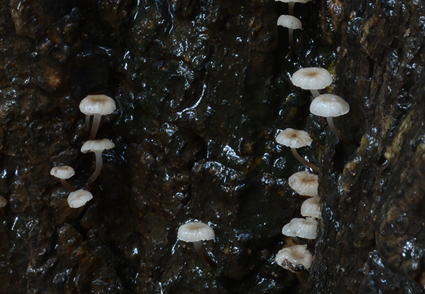Abstract
Porotheleum microsporum, a new agaricoid species of the genus Porotheleum (Porotheleaceae, Agaricales), was found growing on the live bark of Salix babylonica in Quancheng Park (Ji’nan City, Shangdong Province, China). This discovery, a testament to our rigorous research, is described and illustrated based on morphological, molecular, and ecological evidence. Our phylogenetic analyses based on DNA sequences of the internal transcribed spacers 1 and 2 with the 5.8S rDNA (ITS) and the large subunit of nuclear ribosomal DNA (LSU) support the inclusion of this new species in the genus Porotheleum as it forms an independent clade in the phylogenetic tree. Morphologically, P. microsporum differs from any known species by combining a pale-yellow pileus with an ochre-yellow center and relatively small basidiospores.
References
- Cooke, W.B. (1957) The Porotheleaceae: Porotheleum. Mycologia 49 (5): 680–693. https://doi.org/10.1080/00275514.1957.12024680
- Desjardin, D.E. & Perry, B.A. (2017) The gymnopoid fungi (Basidiomycota, Agaricales) from the Republic of São Tomé and Príncipe, West Africa. Mycosphere 8 (9): 1317–1391. https://doi.org/10.5943/mycosphere/8/9/5
- Dutta, A.K., Antonín, V., Barui, R. & Acharya, K. (2018) A new species of Clitocybula (Marasmiaceae) from West Bengal, India. Nova Hedwigia 107 (1–2): 195–203. https://doi.org/10.1127/nova_hedwigia/2017/0464
- Brazee, N.J., Lindner, D.L., D’Amato, A.W., Fraver, S., Forrester, J.A. & Mladenoff, D.J. (2014) Disturbance and diversity of wood-inhabiting fungi: effects of canopy gaps and downed woody debris. Biodiversity and conservation 23: 2155–2172. https://doi.org/10.1007/s10531-014-0710-x
- Fries, E.M. (1818) Observationes Mycologicae 2. Bonnier, Copenhagen, Denmark.
- Jang, Y., Jang, S., Lee, J., Lee, H., Lim, Y.W., Kim, C. & Kim, J.J. (2016) Diversity of wood-inhabiting polyporoid and corticioid fungi in Odaesan National Park, Korea. Mycobiology 44 (4): 217–236. https://doi.org/10.5941/MYCO.2016.44.4.217
- Consiglio, G., Vizzini, A., Cooper, J., Marchetti, M., Angelini, C., Brugaletta, E. & Setti, L. (2021) The agaricoid members of the genus Porotheleum (Porotheleaceae, Agaricales), Porotheleum emend., Porotheleaceae s. stricto, and new genera for Agaricus floccipes and Mycena subalpina. Rivista di Micologia 64 (2): 99–190.
- Doyle, J.J. & Doyle, J. (1987) A rapid DNA isolation procedure for small quantities of fresh leaf material. Phytochemical Bulletin 19: 11–15.
- Gardes, M. & Bruns, T.D. (1993) ITS primers with enhanced specificity for basidiomycetes-application to the identification of mycorrhizae and rusts. Molecular Ecology 2: 113–118. https://doi.org/10.1111/j.1365-294X.1993.tb00005.x
- Hall, T.A. (1999) BioEdit: a user-friendly biological sequence alignment editor and analysis program for windows 95/98/NT. Nucleic Acids Symp Ser 41: 95–98.
- Kornerup, A. & Wanscher, J.H. (1978) Methuen Handbook of Colours. 3 Ed. Eyre Methuen, London, 252 pp.
- Matheny, P.B., Hughes, K.W., Kalichman, J. & Lebeuf, R. (2020) Pulverulina, a new genus of Agaricales for Clitocybe ulmicola. Southeastern Naturalist 19 (3): 447–459. https://doi.org/10.1656/058.019.0301
- Murrill, W.A. (1916) Porotheliaceae. Mycologia 8: 56. https://doi.org/10.2307/3753071
- Nylander, J.A.A. (2004) MrModelTest v2. Program distributed by the editor. https://doi.org/10.1049/cp:20040370
- Ronquist, F. & Huelsenbeck, J.P. (2003) MrBayes 3: Bayesian phylogenetic inference under mixed models. Bioinformatics 19: 1572–1574. https://doi.org/10.1093/bioinformatics/btg180
- Senanayake, I.C., Rossi, W., Leonardi, M., Weir, A., McHugh, M., Rajeshkumar, K.C., Verma, R.K., Karunarathna, S.C., Tibpromma, S., Ashtekar, N. & Ashtamoorthy, S.K. (2023) Fungal diversity notes 1611–1716: taxonomic and phylogenetic contributions on fungal genera and species emphasis in south China. Fungal Diversity 122 (1): 161–403. https://doi.org/10.1007/s13225-023-00523-6
- Schoch, C.L., Robbertse, B., Robert, V., Vu, D., Cardinali, G., Irinyi, L., Meyer, W., Nilsson, R.H., Hughes, K., Miller, A.N. & Kirk, P.M. (2014) Finding needles in haystacks: linking scientific names, reference specimens and molecular data for Fungi. Database 2014: bau061. https://doi.org/10.1093/database/bau061
- Smith, S.A. & Dunn, C.W. (2008) Phyutility: a phyloinformatics tool for trees, alignments and molecular data. Bioinformatics 24: 715–716. https://doi.org/10.1093/bioinformatics/btm619
- Song, X.H., Lv, X.B. & Li, C.R. (2015) Willingness and motivation of residents to pay for conservation of urban green spaces in Jinan, China. Acta Ecologica Sinica 35 (4): 89–94. https://doi.org/10.1016/j.chnaes.2015.06.003
- Stamatakis, A. (2006) RAxML-VI-HPC: maximum likelihood-based phylogenetic analyses with thousands of taxa and mixed models. Bioinformatics 22: 2688–2690. https://doi.org/10.1093/bioinformatics/btl446
- Su, Y.Y., Guo, L.D. & Hyde, K.D. (2010) Response of endophytic fungi of Stipa grandis to experimental plant function group removal in Inner Mongolia steppe, China. Fungal Diversity 43: 93–101. https://doi.org/10.1007/s13225-010-0040-6
- Vilgalys, R. & Hester, M. (1990) Rapid genetic identification and mapping of enzymatically amplified ribosomal DNA from several Cryptococcus species. The Journal of Bacteriology 172 (8): 4238–4246. https://doi.org/10.1128/jb.172.8.4238-4246.1990
- Vizzini, A., Consiglio, G., Marchetti, M., Borovička, J., Campo, E., Cooper, J., Lebeuf, R. & Ševčíková, H. (2022) New data in Porotheleaceae and Cyphellaceae: epitypification of Prunulus scabripes Murrill, the status of Mycopan Redhead, Moncalvo & Vilgalys and a new combination in Pleurella Horak emend. Mycological Progress 21 (4): 44. https://doi.org/10.1007/s11557-022-01795-z
- Vu, D., Groenewald, M., De Vries, M., Gehrmann, T., Stielow, B., Eberhardt, U., Al-Hatmi, A., Groenewald, J.Z., Cardinali, G., Houbraken, J. & Boekhout, T. (2019) Large-scale generation and analysis of filamentous fungal DNA barcodes boosts coverage for kingdom fungi and reveals thresholds for fungal species and higher taxon delimitation. Studies in mycology 92 (1): 135–154. https://doi.org/10.1016/j.simyco.2018.05.001
- Wang, P.M., Liu, X.B., Dai, Y.C., Horak, E., Steffen, K. & Yang, Z.L. (2018) Phylogeny and species delimitation of Flammulina: taxonomic status of winter mushroom in East Asia and a new European species identified using an integrated approach. Mycological Progress 17: 1013–1030. https://doi.org/10.1007/s11557-018-1409-2
- Wang, P.M. & Yang, Z.L. (2019) Two new taxa of the Auriscalpium vulgare species complex with substrate preferences. Mycological Progress 18: 641–652. https://doi.org/10.1007/s11557-019-01477-3
- White, T.J., Bruns, T., Lee, S. & Taylor, J. (1990) Amplification and direct sequencing of fungal ribosomal RNA genes for phylogenetics. In: Innis, M.A., Gelfand, D.H., Sninsky, J.J. & White, T.J. (Eds.) PCR Protocols: a guide to methods and applications. San Diego, Academic Press, pp. 315–322. https://doi.org/10.1016/B978-0-12-372180-8.50042-1


